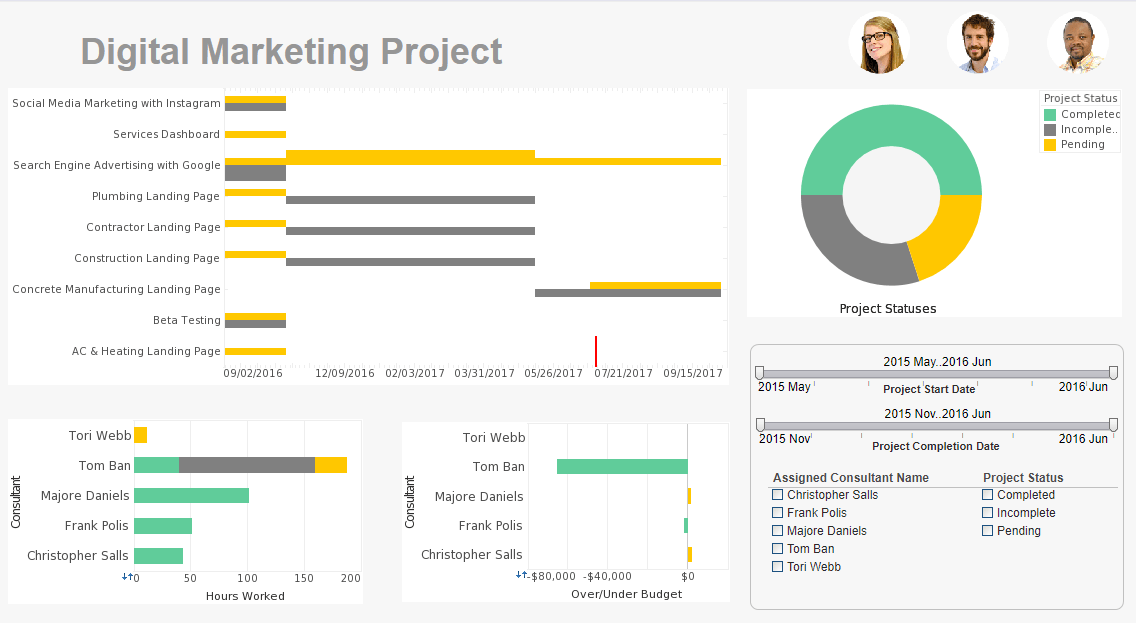What KPIs and Analytics Do Project Analysts Use?
Understanding key performance indicators (KPIs) and analytics as a project analyst is crucial to making sure a project is successful. Project analysts may use these indicators to monitor progress, spot possible problems, and reach data-driven conclusions. We'll look at some of the most popular KPIs and analytics in project management in this post.
| #1 Ranking: Read how InetSoft was rated #1 for user adoption in G2's user survey-based index | Read More |
Project Scope KPIs
The effort required to get the intended result is referred to as the project's scope. Project analysts may gauge a project's advancement in relation to its initial scope with the use of project scope KPIs. The most typical scope KPIs are as follows:
- Scope Creep: Any unauthorized additions or modifications to the project scope are referred to as scope creep. Monitoring changes in the project's scope over time will allow project analysts to assess scope creep.
- Requirements Coverage: The proportion of the project's requirements that have been met is measured by requirements coverage. Project analysts may check if all project criteria are being satisfied with the use of this KPI.
Deliverable Completion: The proportion of project deliverables that have been finished is measured by delivery completion. Project analysts may use this KPI to monitor if all project deliverables are being made on schedule and within budget.
Project Schedule KPIs
Project analysts may gauge a project's progress in relation to its initial timeline with the use of project schedule KPIs. The most typical scheduling KPIs are as follows:
- Schedule Variance: The difference between the actual schedule and the intended timetable is measured as schedule variance. This KPI aids project analysts in identifying any schedule delays or accelerations.
- Schedule Performance Index: The project schedule's effectiveness is measured by the schedule performance index. This KPI aids project analysts in determining if the project is on time or behind.
Critical Path: The sequence of activities that must be completed in order for the project to be finished on time is known as the critical path. This KPI may be used by project analysts to spot possible delays in the critical route and, if required, take remedial action.
Project Cost KPIs
Project analysts may compare a project's cost to its budget with the use of project cost KPIs. The most typical cost KPIs are as follows:
- Cost Variance: Cost variance is a measurement of the discrepancy between the actual cost and the budgeted cost. This KPI aids project analysts in identifying any cost reductions or overruns.
- Cost Performance Index: The project budget's effectiveness is gauged by the cost performance index. This KPI aids project analysts in determining the project's budget status.
- Return on Investment: The project's return on investment compares the project's financial gains to its costs. This KPI may be used by project analysts to assess if the project is producing a healthy return on investment.
Risk and Issue KPIs
Issue and risk Project analysts may assess the possibility and consequences of prospective risks and hazards using KPIs. The following are some of the most popular risk and problem KPIs:
- Risk Exposure: Risk exposure quantifies a risk's probability and possible effects. Project analysts may detect and rank hazards with the use of this KPI.
- Issue Resolution: The efficacy and speed of problem resolution are measured. This KPI assists project analysts in making sure that problems are resolved quickly and effectively.
- Change Request Approval Rate: The proportion of change requests that are granted is measured by the change request approval rate. This KPI aids project analysts in making sure that modifications to the project are authorized quickly and efficiently.
 |
Learn about the top 10 features of embedded business intelligence. |
Quality KPIs
Project analysts may assess the quality of the project deliverables with the use of quality KPIs. The most typical quality KPIs are as follows:
- Defect Density: The defect density calculates how many flaws there are in each unit of work. This KPI aids project analysts in identifying potential areas for raising the quality of the deliverables.
- Test Coverage: The amount of project requirements that have undergone sufficient testing is measured by test coverage. This KPI aids project analysts in making sure that every project need is tested thoroughly to assure quality.
- Customer Satisfaction: The level of stakeholder satisfaction with the project's deliverables is measured by customer satisfaction. The project's stakeholders' requirements and expectations are met by the project, thanks to this KPI, according to project analysts.
Analytics
Project analysts may utilize analytics to learn more about the performance of a project in addition to KPIs. Among the often-used analytics are:
- Trend Analysis: Analyzing trends entails monitoring KPI performance over time to spot patterns and trends. Project analysts may use this research to pinpoint areas where performance is rising or falling and take the necessary measures.
- Root Cause Analysis: Finding the fundamental causes of problems and dangers is part of the root cause analysis process. Project analysts employ this analysis to address the underlying causes of problems and stop them from happening again.
- Predictive Analytics: Utilizing previous data to forecast future performance is known as predictive analytics. Project analysts may detect possible problems using this analysis and take preventative action to avoid them.



